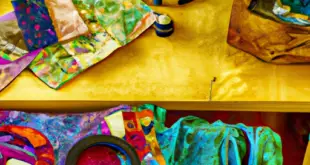Screen printing and block printing are two creative and innovative techniques that allow individuals to unlock their imagination and express their artistic ideas on textiles. These DIY methods provide an avenue for individuals to explore their creativity and produce unique designs on various fabrics.
By understanding the basics of screen printing and block printing, as well as acquiring the essential tools and materials, anyone can embark on a journey of textile printing and bring their imagination to life.
Screen printing involves transferring ink through a mesh screen onto a substrate, such as fabric, to create a desired design. This technique allows for precise and detailed prints, making it a popular choice for artists and designers.
On the other hand, block printing involves carving a design onto a block of material, such as linoleum or wood, and using that block to apply ink onto the fabric. This method provides a more hands-on approach, allowing for a range of textures and patterns to be created.
Both techniques offer endless possibilities for customization and innovation, making them ideal for individuals who have a subconscious desire for creative exploration and expression.
By delving into the world of DIY screen printing and block printing on textiles, individuals can tap into their inner artist and unleash their imagination. Through this article, we will explore the basics of these techniques, provide a step-by-step guide for screen printing on textiles, and delve into various block printing techniques and designs.
Whether you are a seasoned artist or a beginner looking to explore your creative side, this article will equip you with the knowledge and inspiration to embark on a textile printing journey that is filled with innovation and endless possibilities.
Understanding the Basics of Screen Printing and Block Printing
Screen printing and block printing are traditional textile printing techniques that involve the transfer of ink onto fabric using a stencil or a carved block respectively.
Screen printing, also known as silk screen printing, is a method where a mesh screen is used to transfer ink onto the fabric. The screen is stretched tightly over a frame, and a stencil is created on the screen to define the areas where ink will pass through. A squeegee is then used to press the ink through the stencil and onto the fabric, creating the desired design. This technique allows for precise and detailed prints, making it a popular choice for creating large quantities of printed textiles.
On the other hand, block printing is a method where a design is carved onto a block of material, such as wood or linoleum. The carved block is then coated with ink and pressed onto the fabric to create the print. Block printing allows for more intricate designs and a greater level of customization, as each block can be carved to create a unique pattern. This technique has been used for centuries in various cultures around the world, and it continues to be a popular choice for creating handcrafted and artistic prints.
Both screen printing and block printing offer a wide range of possibilities for textile design. They allow for experimentation with colors, patterns, and textures, and they provide a creative outlet for those looking to express their artistic ideas. These techniques provide an opportunity to unlock one’s imagination and explore the endless possibilities of textile printing.
Whether you choose screen printing for its precision and efficiency or block printing for its handmade charm, both techniques offer a way to bring your innovative ideas to life on fabric.
Essential Tools and Materials for DIY Printing
To successfully engage in the process of textile printing, one must possess a set of essential tools and materials. These tools and materials are crucial in achieving the desired results and ensuring the longevity of the printed design.
One of the primary tools needed for both screen printing and block printing is a printing screen or a printing block, respectively. The screen acts as a stencil for screen printing, while the block is carved with the desired design for block printing. Additionally, a squeegee is essential for both methods as it is used to apply pressure and evenly distribute the ink onto the fabric.
In addition to the printing tools, there are various materials required for DIY printing. Firstly, fabric is the canvas for the design and must be carefully chosen to ensure it is suitable for the printing process. Cotton is a popular choice due to its absorbency and ability to hold the ink well.
Other materials such as paper or cardboard are needed for creating stencils or templates for the design. These materials provide a guide for the printing process, ensuring precision and accuracy.
Lastly, a printing ink or paint is needed to bring the design to life. Water-based inks are commonly used as they are eco-friendly and easy to work with.
Overall, having the right tools and materials is crucial for successful DIY printing and allows individuals to unlock their imagination and bring their innovative ideas to life.
Step-by-Step Guide to Screen Printing on Textiles
A step-by-step guide to achieve high-quality textile prints through the process of screen printing starts with preparing the screen. The screen should be clean and free from any debris or previous ink residue.
Next, a stencil or design is created, which will determine the areas where ink will be applied. This can be done by using a stencil material or by using a photosensitive emulsion that is exposed to light with the desired design. After the stencil is ready, it is placed on top of the screen and secured tightly.
Once the screen is prepared, the ink is applied. The desired color of ink is poured onto one end of the screen and then spread evenly across the stencil using a squeegee. The squeegee is moved back and forth across the screen, ensuring that the ink goes through the stencil and onto the fabric beneath. The pressure applied and the speed of the squeegee movement can affect the outcome of the print, so it is important to experiment and practice to achieve the desired result.
Once the ink is applied, the fabric is carefully lifted off the screen, revealing the printed design. The fabric should be allowed to dry completely before further handling or washing to ensure the ink sets properly.
Screen printing on textiles offers a versatile and creative way to express oneself through printing designs onto fabric. It is a process that requires careful preparation and attention to detail, but with practice and experimentation, high-quality prints can be achieved.
By following the step-by-step guide outlined above, individuals can unlock their imagination and explore the endless possibilities of DIY screen printing. Whether it is creating unique clothing, personalized home decor, or one-of-a-kind gifts, screen printing on textiles allows for innovation and individuality to shine through.
Exploring Block Printing Techniques and Designs
Exploring various techniques and designs in the realm of block printing can offer individuals a multitude of possibilities for creating unique and visually captivating textile prints.
Block printing is a traditional form of textile printing that involves carving a design onto a block of material, usually wood, and then using that block to transfer the design onto fabric.
One of the most popular block printing techniques is known as relief printing, where the areas that are carved away do not transfer ink onto the fabric, while the raised areas of the block leave an impression. This technique allows for bold and graphic designs that can be easily replicated.
Block printing offers a wide range of design possibilities, from simple geometric shapes to intricate patterns and motifs. Artists and designers can experiment with different types of blocks, such as linoleum or rubber, to achieve different effects and textures. They can also use various inks or dyes to create different color schemes and effects.
Additionally, artists can combine multiple blocks to create layered and complex designs. The versatility of block printing allows for endless creativity and innovation, making it a popular choice for textile artists and designers looking to add a personal touch to their work.
Conclusion
In conclusion, screen printing and block printing are two versatile and creative techniques that allow individuals to express their imagination on textiles. By understanding the basics of these methods and equipping oneself with the essential tools and materials, anyone can embark on a DIY printing journey.
Through a step-by-step guide, individuals can learn the intricacies of screen printing on textiles, from preparing the screen to applying the ink. Additionally, exploring block printing techniques and designs opens up a world of possibilities for creating unique and personalized patterns on fabric.
Screen printing requires attention to detail and precision, ensuring that each layer of ink is accurately applied to create a vibrant and professional-looking design. Block printing, on the other hand, allows for more artistic freedom, with various techniques such as carving, stamping, and layering. Both methods provide individuals with the opportunity to unleash their creativity and transform plain textiles into works of art.
By following the steps and techniques outlined in this article, anyone can unlock their imagination and bring their designs to life on fabric. So, grab your tools, gather your materials, and let your creativity soar with DIY screen printing and block printing on textiles.
 printablelabelstemplate
printablelabelstemplate
